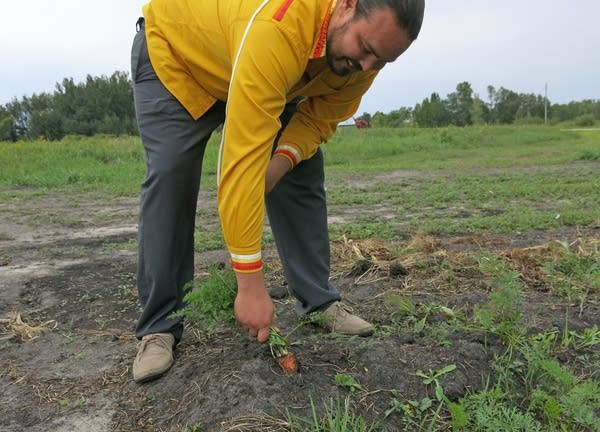Fish guts, heritage tomatoes: Red Lake works to feed its own

Red Lake Indian Reservation leaders hope within a few years to feed the roughly 5,000 tribal members who live there with fresh, organic produce grown on the reservation. It's an enormous task that sounds more biblical than doable.
Tribal leaders, though, have a plan. It began in a garden and a lot of it has to do with fish guts.
The tribe's first step toward what leaders call food sovereignty was a small test plot planted last year — about an acre of peppers, kale, and pretty much any other vegetable you can grow in northern Minnesota. It wasn't terribly successful at first.
Last fall, tribal economic development director Sam Strong had a few thousand pounds of fish guts hauled in from the tribe's walleye processing facility, and tilled into the ground. Now the tomato plants are 8 feet tall.
Create a More Connected Minnesota
MPR News is your trusted resource for the news you need. With your support, MPR News brings accessible, courageous journalism and authentic conversation to everyone - free of paywalls and barriers. Your gift makes a difference.

"I heard a lot of stories about traditional uses of fish heads and the waste products of fish," he said. "They would bury it, just right next to the plant. If you think about it, fish guts are comprised of nitrogen. It's the perfect fertilizer."
It's an extremely productive garden. Test garden manager David Manuel and his trainees are bringing bushels of produce to the tribe's elders, and selling kale at a co-op in Bemidji. Manuel, though, said it's not really enough.
"It's a big garden," he said. "Don't get me wrong, but when it comes to feeding the 5,000-plus people here on the reservation, we just can't do it right from here."

This spring, they expanded to another 4-acre patch of farmland on the southwestern border of the reservation. It's not as lush yet, but Manuel says a few tons of fish guts will do the trick.
Red Lake has no shortage of fish guts. Every year, anglers pull 1 million pounds of walleye from the lake. Only about half of that leaves the tribe's processing facility as usable fillets. The rest is made of bones, heads and guts. Enough, Manuel says, to grow miles of 8-foot tomato plants.
The tribe is also working on an industrial indoor growing facility, and high fences for a bison herd being shipped in later this fall.
There's some urgency involved with the project. Research from the Notah Begay foundation, a nonprofit native health organization, shows that nearly half of all native children are obese by age 10, and will likely develop Type 2 diabetes at some point in their lives.

"We have rampant diabetes," Manuel said. "We have rampant childhood diabetes. We're in a health crisis."
Right now, most of those living on the reservation buy their food at the Bemidji Walmart.
Manuel, though, figures if the tribe can distribute local organic foods through the school system, and to the elders — if they can make bison meat and poblano peppers easier to get than processed food — Red Lake might be able to eat smarter and healthier.
It's not terribly farfetched. The Red Lake Nation already produces a lot of food. There's the walleye fishery, which on its own could very nearly provide everyone on the reservation with protein, year round.

The tribe also farms 800 acres of domestic wild rice. Those resources have mostly been sold off the reservation, until now, Strong said.
"We're getting to a point where we realize that food is medicine," he said. "We're realizing we need to make that investment in our own people, to combat diabetes and cancer."
The fishery and the wild rice still has to make a profit to be sustainable, he added. But now, those profits are paying for more hydroponics, and bison herds, and those great tomatoes, so flavorful that Manuel calls them candy.
"Taste them," he said. "My God. Have you ever tasted fruit like that?"
Strong hopes in about five years there will be enough for everyone.